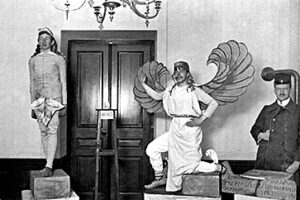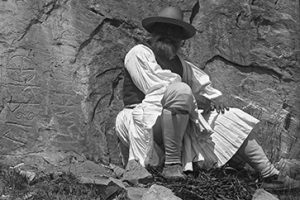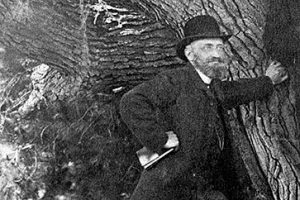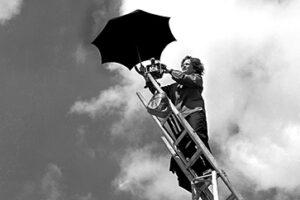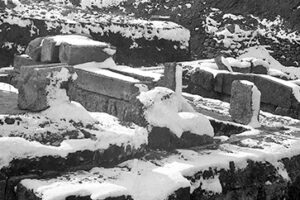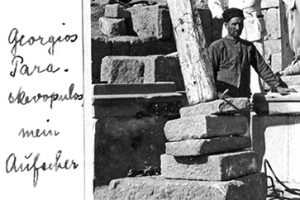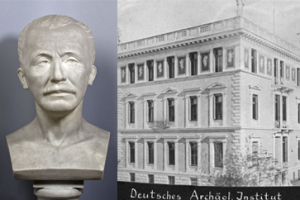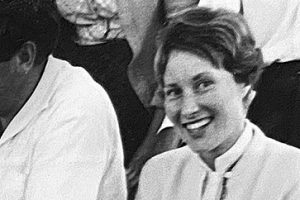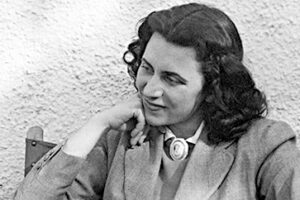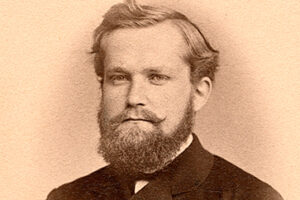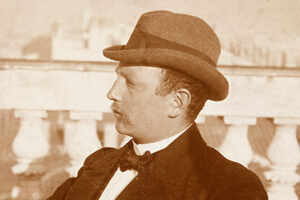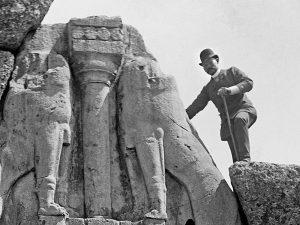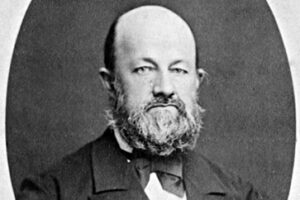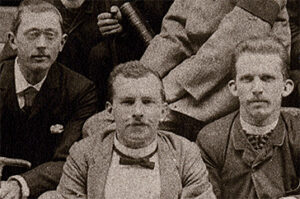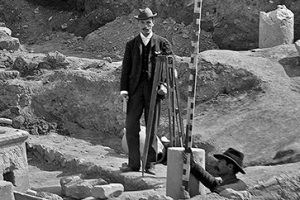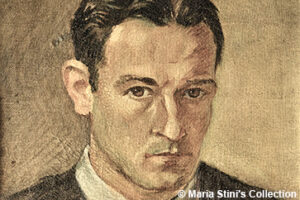- “Den kleinen Fredrich hatten wir als Bäuerin verkleidet …” – Carnival at the DAI Athens 1896–1910by Katharina BrandtWhen Engelbert Drerup arrived in Athens in February 1896 after a tiring journey from Italy, he was immediately immersed in the boisterous greek Carnival activities underway at the DAI: “At the Institute, right away I met Mr. Dörpfeld, Mr. Wolters, and Mr. Wilhelm, i.e. the leading figures at the German and Austrian station, the first of whom invited me right … Read More
- Angelis Kosmopoulos (c.1843–1937)by Katharina Brandt“Everyone who has ever been involved with the German Institute and its work knows this man” This entry is dedicated to Angelis Kosmopoulos, a Greek who helped shape the image of the German Archaeological Institute at Athens for decades. The basic facts of Angelis Kosmopoulos’s life (ca. 1843–1937) have been recounted many times, and are well-known (Goessler 1951, 32; Moustaka … Read More
- Eugen Petersen (1836–1919)by Katharina BrandtThe classical archaeologist Eugen Petersen is known primarily as the long-serving director of DAI Rome. His name is not, however, necessarily associated with the DAI Athens: a good reason to remember him here and recount his time at the Athenian department. The Centraldirektion (Executive Committee [EC]) of the DAI appointed Eugen Petersen First Secretary of the department in 1886. He … Read More
- Eva-Maria Czakó (1918–2012) – the first and only female photographer at the DAI Athensby Katharina BrandtEva-Maria Czakó (19.12.1918–16.6.2012) was the first and remains the only female photographer at the DAI Athens. When the Institute was reopened after the Second World War, she worked as a professional photographer from 1954 to 1962, capturing in her photos Greek antiquities and, of course, the Institute’s excavations and finds. Youth and early career After studying art history, Czakó trained … Read More
- Excavating the Kabireion near Thebes – it began as a winter tale … of sortsby Katharina BrandtOn this day, 135 years ago, on the 20th of December 1887, the excavation of the Kabireion near Thebes in Boetia started by members of the DAI Athens and travel grant holders of the DAI. Little did they know that they would initiate a project that would last until the 1970s, almost a century. In the fall of 1887, Paul … Read More
- Georgios Paraskevopoulosby Katharina BrandtIn addition to Angelis Kosmopoulos who was among other things famous for his beard and fustanella, there was another Greek foreman who played an important part in the early excavations of the DAI. However, his legacy is not nearly as conspicuous to outsiders and thus he remains far less well-known today: his name is Georgios Paraskevopoulos. He is not, however, … Read More
- Heinrich Schliemann (1822–1890)by Katja SpornHeinrich Schliemann (1822–1890) and the DAI Athens Heinrich Schliemann, whose two-hundredth birthday was celebrated earlier this year (* Jan. 6, 1822; † Dec. 26, 1890), was important to the German Archeological Institute in a particular way. When the Department in Athens was founded in 1874, it originally had no premises of its own. Instead, it operated out of a rented … Read More
- Hildegund Gropengiesser (1928–2019)by Katharina BrandtHildegund Gropengiesser (*Jan. 15th 1928, †June 16th 2019) was one of the first female German archeologists to participate actively in field campaigns in Greece. She witnessed the reopening of the Athens Department of the DAI after WWII and was one of the first German women to have a successful career as a classical archeologist. She first came into contact with … Read More
- Maria Tzannetaki (1925–2004) A Pillar of the Athens Department during the Emil Kunze yearsby Katja SpornWhile there is abundant information about former directors and aides of the Institute in comprehensive accounts of its history, in obituaries, and in Festschriften, things are very different for people who did not publish or whose names do not appear in printed documents. It is not easy to get a picture of the active support personnel whose efforts made smooth … Read More
- Otto Lüders (1844 – 1912) – the first director of the DAI Athensby Dimitris GrigoropoulosWhen the Athens department of the DAI was formally founded in 1874, the philologist-turned-diplomat Otto Lüders was the first person to be appointed as its director, at the time called the Sekretar (“Secretary”). He held this position only briefly, and until recently very little was known about his time at the DAI. Fortunately, recent work on the institute’s archive in … Read More
- Otto Rubensohn and the excavations of the DAI in Paros (1898–1899)by Vasiliki Barlou-JaeggiOn June 17, 1898, 125 years ago, a young Jewish German archaeologist arrived at Parikia, the capital of the island of Paros, after an exhausting 13-hour voyage from Piraeus. His name was Otto Rubensohn (1867–1964, fig. 1) and his mission was to conduct small-scale excavations on behalf of the DAI Athens. One of his primary goals was to search for … Read More
- Schliemann at the Lion Gate? – ‘Mykene 63’ – a starting point for much moreby Katharina BrandtThe photograph known as ‘Mykene 63’, which allegedly shows Heinrich Schliemann standing next to the famous Lion Gate of Mycenae, is undoubtedly one of the most renowned images kept in the photographic archive of the DAI Athens. Since this year marks Heinrich Schliemann’s 200th birthday, it is a fitting occasion to set the record straight and tell the real story … Read More
- The astronomer Johann Friedrich Julius Schmidt (1825-1884) and the DAI Athensby Veronika FührerAmong the holdings of the DAI Athens archive, there is a fragmented personal diary whose author had not been identified until recently, as the handwriting, a hastily written cursive script (›Kurrentschrift‹), is difficult to read. In early April 2022, Katharina Brandt identified the author as the astronomer Johann Friedrich Julius Schmidt, who was born in Eutin on October 26, 1825 … Read More
- Theodor Wiegand (1864–1936) – His rocky road to archaeologyby Marie-Christin KünzelmannTheodor Wiegand – the famous excavator of Priene, Miletus and Didyma – began his career under unfavourable auspices. When he came to the DAI Athens, he was uncertain about his future. His time at the Institute, however, shaped him profoundly; it was here that he became the practical archaeologist and excavator as he is still known today. Much has been … Read More
- Wilhelm Wilberg (1872–1956) and his familyby Katharina BrandtSeveral members of the Wilberg family have been closely connected to the DAI Athens since its establishment in 1874, especially Karl Wilberg, an Athenian bookseller and consul, and his son, Wilhelm, who served as Wilhelm Dörpfeld’s assistant on excavations. This entry was prompted by the recent publication of the book ›Bauzeichnung und Rekonstruktion. Der Bauforscher Wilhelm Wilberg und die Archäologie … Read More
- Yannis Stinis (1914–2001) – A brief overview of the work of a painter and printmaker who worked with the German Archaeological Instituteby Charis KanellopoulouLaborious and prolific painter Yannis Stinis (Athens, 1914–2001) (fig. 1) produced works that reveal his interest in the lively representation of the Greek landscape. Stinis was also a printmaker and banknote designer, belonging to the artistic staff of the Bank of Greece Printing Works (National Mint/IETA) that contributed, from 1940 onwards, to the development of the art of the national … Read More
All posts
We use cookies on our website. By clicking “Accept”, you consent to the use of ALL the cookies.
Manage consent
Privacy Overview
This website uses cookies to improve your experience while you navigate through the website. Out of these, the cookies that are categorized as necessary are stored on your browser as they are essential for the working of basic functionalities of the website. We also use third-party cookies that help us analyze and understand how you use this website. These cookies will be stored in your browser only with your consent. You also have the option to opt-out of these cookies. But opting out of some of these cookies may affect your browsing experience.
Necessary cookies are absolutely essential for the website to function properly. This category only includes cookies that ensures basic functionalities and security features of the website. These cookies do not store any personal information.
Functional cookies help to perform certain functionalities like sharing the content of the website on social media platforms, collect feedbacks, and other third-party features.
Performance cookies are used to understand and analyze the key performance indexes of the website which helps in delivering a better user experience for the visitors.
Analytical cookies are used to understand how visitors interact with the website. These cookies help provide information on metrics the number of visitors, bounce rate, traffic source, etc.
Advertisement cookies are used to provide visitors with relevant ads and marketing campaigns. These cookies track visitors across websites and collect information to provide customized ads.
Other uncategorized cookies are those that are being analyzed and have not been classified into a category as yet.
| Cookie | Duration | Description |
|---|---|---|
| _pk_id.54.4aa2 | 1 year 27 days | No description |
| _pk_ses.54.4aa2 | 30 minutes | No description |
| cookielawinfo-checkbox-functional | 1 year | The cookie is set by GDPR cookie consent to record the user consent for the cookies in the category "Functional". |
| cookielawinfo-checkbox-others | 1 year | No description |
